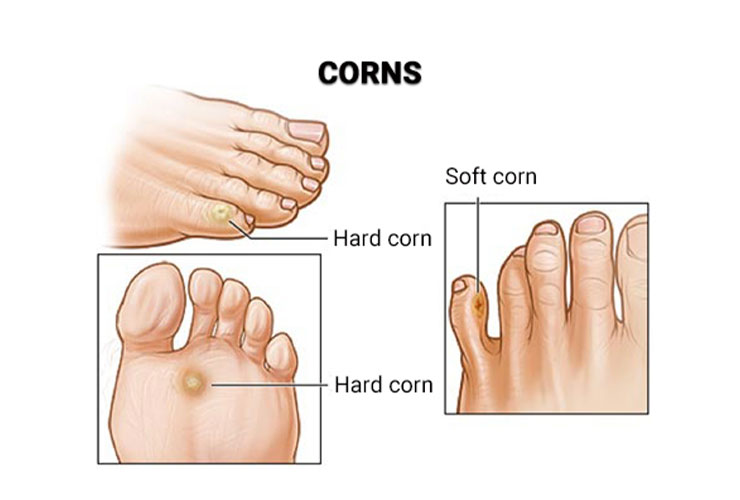Corns can be a real pain, quite literally. These small, hardened areas of skin on your feet can make every step excruciating. But fear not! Satvic Multispeciality Clinic is here to provide you with top-notch corn foot treatment that will have you walking comfortably again. In this comprehensive guide, we’ll delve into the various treatment options offered by Satvic Multispeciality Clinic and help you understand how to bid farewell to those pesky corns for good.
Table of Contents
- Understanding Corns
- Causes and Risk Factors
- Corn Foot Treatment Options
- Prevention Tips
- When to Consult a Specialist
- Patient Success Stories
- Questions & Answers
Understanding Corns
Corns, medically known as helomas, are thickened, localized areas of dead skin that typically develop on the feet and toes. They often form in response to friction or pressure, such as from ill-fitting shoes or repetitive movements. Corns can be painful, especially when they press against underlying nerve endings.
Causes and Risk Factors
Several factors can contribute to the development of corns. These include:
- Wearing tight or high-heeled shoes that squeeze the toes.
- Having deformities like bunions or hammertoes.
- Engaging in activities that put excess pressure on the feet.
Understanding the root causes of corns is essential in preventing their recurrence. At Satvic Multispeciality Clinic, our experts will assess your unique situation to determine the underlying causes and tailor a treatment plan accordingly.
Corn Foot Treatment Options
Satvic Multispeciality Clinic offers a range of effective corn foot treatment options to address your specific needs. Our experienced team of podiatrists and specialists will work closely with you to choose the most suitable treatment. Here are some of the options available:
1. Medication
In some cases, topical medications may be prescribed to soften the corn and reduce discomfort. These medications typically contain salicylic acid, which helps break down the thickened skin.
2. Custom Orthotics
If your corns are related to structural issues with your feet, custom-made orthotic inserts may be recommended. These inserts provide support and reduce friction, preventing further corn development.
3. Corn Removal
For more stubborn corns, our specialists may perform a minor surgical procedure to remove the hardened tissue. Rest assured, this is a safe and minimally invasive procedure that can bring significant relief.
4. Footwear Recommendations
We’ll advise you on suitable footwear choices that reduce pressure and friction on your feet. Wearing the right shoes can make a world of difference in preventing corns from reoccurring.
Prevention Tips
Preventing corns is just as important as treating them. Here are some tips to keep your feet corn-free:
- Choose comfortable, well-fitting shoes with ample toe room.
- Avoid high heels or shoes with narrow toe boxes for extended periods.
- Maintain proper foot hygiene by keeping your feet clean and moisturized.
- Trim your toenails carefully to prevent ingrown toenails.
When to Consult a Specialist
If you notice persistent corns, it’s crucial to consult a specialist at Satvic Multispeciality Clinic. Delaying treatment can lead to worsening pain and complications. Our team will assess your condition and recommend the most suitable course of action.
Patient Success Stories
Don’t just take our word for it. Hear from our satisfied patients who have successfully undergone corn foot treatment at Satvic Multispeciality Clinic. Their stories serve as a testament to our expertise and dedication to providing relief.
Questions & Answers
The common symptoms of corns include localized pain, thickened skin, and the development of a hard bump on the affected area.
No, corn removal at Satvic Multispeciality Clinic is a minimally invasive procedure performed under local anesthesia. You may experience some discomfort during recovery, but the procedure itself is relatively painless.
Yes, corns can reoccur if the underlying causes, such as footwear choices or foot deformities, are not addressed. Our specialists will provide guidance on prevention to reduce the risk of recurrence.
The recovery time varies from person to person. Typically, it takes a few weeks for the skin to heal completely. During this time, it’s essential to follow post-operative care instructions provided by our team.
No, corns are not contagious. They are a result of localized pressure and friction on the skin and cannot be spread to others.
Don’t let corns hinder your mobility and comfort any longer. Satvic Multispeciality Clinic is your partner in corn foot treatment, offering effective solutions tailored to your unique needs. Contact us today to schedule an appointment and take the first step toward corn-free feet.
Contact Satvic Multispeciality Clinic: www.satvicclinic.com
Disclaimer
The information provided in this article is for educational purposes and should not be considered a substitute for medical advice. Always consult with a qualified healthcare professional for proper diagnosis and treatment of corns or any other medical condition.

